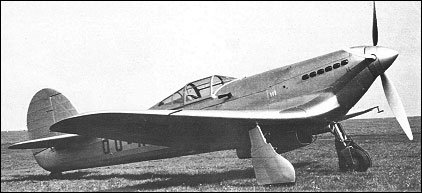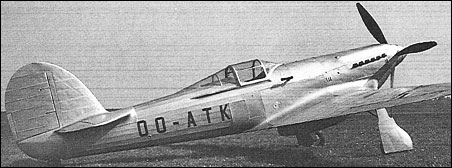|
| Developed in parallel with the R-37, the R-38 was
essentially similar to the R-36 apart from having a
1030hp Rolls-Royce Merlin II engine. It was originally
proposed with wings of two different sizes, but the sole
prototype retained a similar wing to that of the R-36 and
R-37. Armament comprised four wing-mounted 7.7mm
or 13.2mm machine guns. The R-38 flew for the first
time on 4 August 1939, and gave excellent results
during its test programme, which was still in process when German forces occupied Belgium. The sole prototype
was flown to Bordeaux when the final collapse of
Belgian resistance became inevitable, but was
scrapped after capture in France by German forces.
| WEIGHTS |
| Take-off weight | 2600 kg | 5732 lb |
| Empty weight | 1950 kg | 4299 lb |
| DIMENSIONS |
| Wingspan | 11.64 m | 38 ft 2 in |
| Length | 8.80 m | 29 ft 10 in |
| Height | 2.90 m | 10 ft 6 in |
| Wing area | 20.00 m2 | 215.28 sq ft |
| PERFORMANCE |
| Max. speed | 545 km/h | 339 mph |
| Range | 1350 km | 839 miles |
| Robert Willis, e-mail, 24.08.2020 02:03 Prior to the German attack on France, the British wasted many hundreds of Merlin engines building the near useless Fairey Battle light bomber. If, by mid 1938, agreements had been made through the Joint Anglo-French Purchasing Commission to acquire on a monthly basis Wright Cyclones to power Short Sunderlands & Empires, as well as P&W Twin Wasps to power Wellingtons; such measures could have freed up enough Pegasus engines to power roughly 225 additional Hampdens. These Hampdens could have been built at the Austin shadow factory in place of the first 450 Battles prior to May 10, 1940. The American engines could have been delivered to Britain instead of being used to build the Martin 167s & Douglas DB7s foolishly ordered by France; the vast majority of which ended up being embargoed; thus delaying their delivery until it was far too late.
In summary, some 450 Renard R-38s could have been delivered (most of which could have been produced by SNCAN) to the French Air Force between April 1939 & June 1940 if the Allies had coordinated their aircraft production programmes. reply |
| Klaatu83, e-mail, 05.08.2015 17:45 Three prototypes of this fighter were built, one with an Hispano-Suiza engine, one with a Gnome-Rhone air-cooled radial engine, and one with a British Rolls-Royce Merlin engine (shown here). None of them went into production, since the Belgians decided to order Hawker Hurricanes instead. Even if this fighter had been chosen for production, it seems doubtful that either the French or the British would have been able to spare enough engines for export to Belgium to complete them. After WW-II began in 1939 these aircraft engines were in great demand in both countries. reply | | Géonet Michel, e-mail, 19.11.2013 12:11 Paul Burniat, Chief-Pilot at the SABCA (constructor), flew the plane during the tests. The first flight was the 4th of augustus 1938 at Evere.
Paul Burniat said : "The flight capabilities and performance of this plane place it between the Hurricane and the Spitfire».
As the R-36, the R-38 was very easy to construct and the cost of the plane (without motor) was only half of the Spitfire
Immatriculé OO-ATK le 22 juin 1939 sous le numéro 473, il fut présenté aux autorités belges le 18 juillet. reply | | Raf2889, e-mail, 05.11.2013 07:59 beautiful aircraft shame it got scrapped. reply | |
| | guba, 18.06.2011 11:26 Belgian resistance became inevitable, but was scrapped after capture in France by German forces. reply |
| rafa, e-mail, 31.10.2008 23:07 that's the most beautifuls fighter that i saw reply |
|
Do you have any comments?
|
| 
COMPANY
PROFILE
All the World's Rotorcraft
|







 Robert Willis
Robert Willis
20
reply